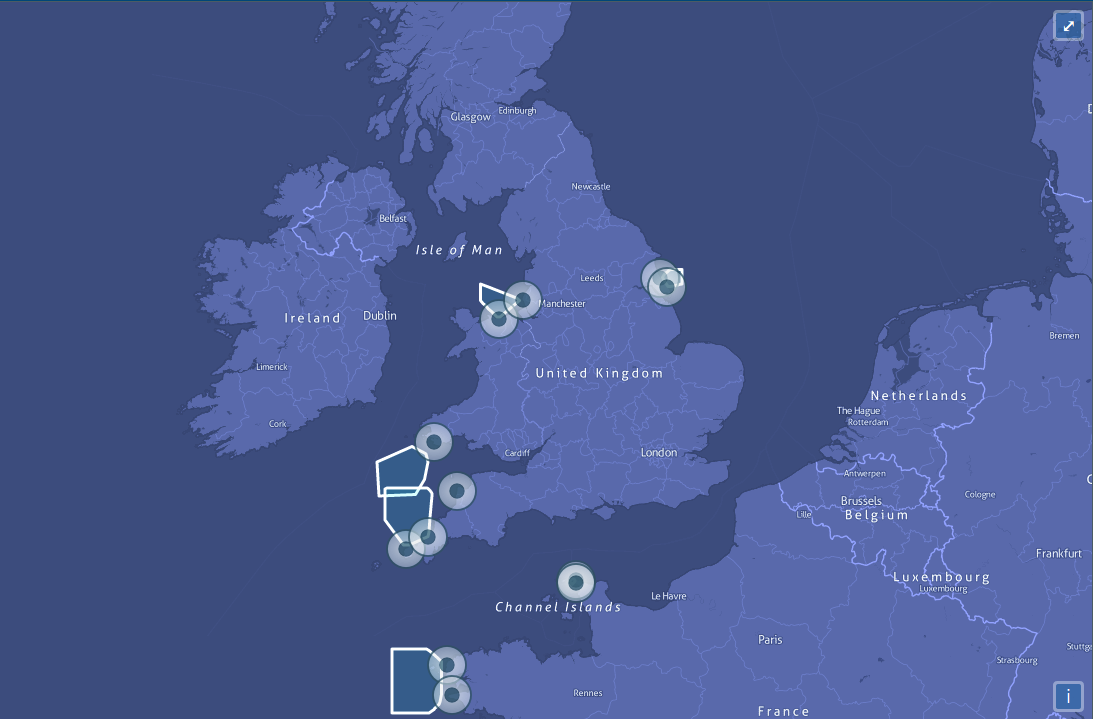Deployments Map
- Click on a point for more details
- Click on the arrow icon for a fullscreen view
- Zoom in for radar coverage and details
Best viewed in fullscreen/landscape on a small screen
Coffs Harbour
- Project
- Coffs Harbour
- Dates
- Radars
- North Nambucca, Red Rock (WERA)
WERA HF radar systems have been deployed in locations around Australia as part of a coordinated network of HF radars delivering quality assured data into a national archive. ACORN is part of the Integrated Marine Observing System (IMOS).
Celtic Sea
- Project
- Pisces HF radar Test Site
- Dates
- June 2017 ongoing
- Radars
- Castlemartin, Nabor Point (Pisces)
This is a joint project with Neptune Radar Ltd that focuses mainly on the reliability of wave measurements with research on a new idea to exploit the fact that different radar operating frequencies have different responses to wave conditions. Swansea University have deployed a directional buoy for validation purposes.
It builds on a previous project, 2003 - 2005, which was aimed at demonstrating the accuracy of the wave measurements at 60 km offshore using a Datawell directional waverider. The accuracy was deemed to be sufficient for operational applications but the planned deployment of radars within WAVENET was cancelled.
Wave data from this deployment can be found on the Cefas Wavenet Interactive Map.
- Select 'Historic deployments'
- Select 'Advanced Mode'
- Click on a measurement position (shown as grey circles)
- Click the 'View selected' button.
Fedje
- Project
- EuroROSE
- Dates
- February 2000 – April 2000
- Radars
- Fedje, Lyngøy (WERA)
The EU funded EuroROSE (European Radar Ocean Sensing) project aimed to demonstrate the use of remote sensing by area-covering HF and X-band radar, combined with high-resolution wave and current models, in the provision of now- and forecasts for vessel management at harbour approaches.
Great Barrier Reef
- Project
- Australian Coastal Ocean Radar Network (ACORN).
- Dates
- November 2007 -
- Radars
- Tannum Sands, Lady Elliot (WERA)
WERA HF radar systems have been deployed in locations around Australia as part of a coordinated network of HF radars delivering quality assured data into a national archive. ACORN is part of the Integrated Marine Observing System (IMOS).
Georgia
- Project
- Skidaway Institute of Oceanography (SkIO)
- Dates
- November 2008
- Radars
- Pritchards, St. Catherine (WERA)
The Skidaway Institute of Oceanography (SkIO – now part of the University of Georgia) and the University of South Carolina are using WERA radar systems to measure ocean surface currents and waves on the Georgia and South Carolina coastlines of the USA.
Gijón
- Project
- EuroROSE
- Dates
- October 2000 – November 2000
- Radars
- Cabo Torres, Cabo Penas (WERA)
The EU funded EuroROSE (European Radar Ocean Sensing) project aimed to demonstrate the use of remote sensing by area-covering HF and X-band radar, combined with high-resolution wave and current models, in the provision of now- and forecasts for vessel management at harbour approaches.
HYD2M
- Project
- HYD2M
- Dates
- Installed June 2018
- Radars
- Goury, Joburg (WERA)
The HYD2M project (Hydrodynamics of Raz Blanchard: Measurements and Modelling) aims to characterize the hydrodynamic processes inside Raz Blanchard and their interactions in order to improve the tidal stream energy estimate.
South Korea
- Project
- KAIST
- Radars
- Korea A, Korea B (WERA)
These radars were operated by the Korean Advanced Institute of Science and Engineering (KAIST). The radars only use 8 antennas in the receive arrays so the data are not ideal for wave measurement but we processed 1 year of their data on our own servers so they could assess the performance.
Liverpool Bay
- Project
- Liverpool Bay Coastal Observatory
- Dates
- August 2005 - December 2011
- Radars
- Formby, Abergele (WERA)
The UK National Oceanography Centre Liverpool deployed the WERA systems within the Coastal Observatory to provide wave, current and wind measurements.
Miami North
- Project
- RSMAS
- Dates
- June 2004
- Radars
- Dania, Virginia (WERA)
For more information visit the Rosenstiel School of Marine and Atmospheric Sciences (RSMAS).
Miami South
- Project
- RSMAS
- Dates
- 2008
- Radars
- Crandon, Largo (WERA)
For more information visit the Rosenstiel School of Marine and Atmospheric Sciences (RSMAS).
Mexico
- Project
- University of Sheffield Reseach
- Dates
- 2007 - 2010
- Radars
- Santa Maria, Cangrejo (WERA)
Petten
- Project
- Dates
- 2002
- Radars
- here, there (Pisces)
Need some blurb for this
Oman
- Project
- Met Office — Oman
- Radars
- LNH Harbour, Turtle Beach (WERA)
The Met Office in Oman have purchased a WERA HF radar system from Helzel GmbH with real time software for wave, current and wind measurement from Seaview Sensing.
Rottnest Shelf
- Project
- Rottnest Shelf
- Dates
- Radars
- Fremantle, Guilderton (WERA)
WERA HF radar systems have been deployed in locations around Australia as part of a coordinated network of HF radars delivering quality assured data into a national archive. ACORN is part of the Integrated Marine Observing System (IMOS).
South Australia Gulf
- Project
- South Australia Gulf
- Dates
- Radars
- Cape Spencer, Cape Wiles (WERA)
WERA HF radar systems have been deployed in locations around Australia as part of a coordinated network of HF radars delivering quality assured data into a national archive. ACORN is part of the Integrated Marine Observing System (IMOS).
Taiwan
- Project
- Harbor and Marine Technology Center
- Dates
- January 2019 – present
- Radars
- Harbor TaiChung North, (WERA)
This single-radar station is owned by Harbor and Marine Technology Center, Ministry of Transportation and Communication, Taiwan and is currently operated by the National Central University (NCU), Taiwan. The University of Hawaii generic HF radar, equipped with 16 antennas in the receive array, is used.
Vigicote
- Project
- SHOM (French Naval Oceanographic Center)
- Dates
- Installed 2009
- Radars
- Garchine, Brezellac (WERA)
These radars are owned by SHOM and operated by ACTIMAR.
Holderness
- Project
- Holderness
- Dates
- May 1994 and June 1995
- Radars
- Aldbrough, Easington (OSCR)
This experiment was part of the Surface Current And Wave Variability EXperiment (SCAWVEX), an EC MAST project to study the variability of waves and currents. Central to the project was the use of HF Radar to measure waves and currents simultaneously. Also fundamental was the intercomparison of different measurement techniques. The WERA radar was developed during this project.
Wave Hub C
- Project
- Wave Hub
- Radars
- Perrenporth, Penden (WERA)
These radars are operated by the University of Plymouth to provide data to assess the resource and impact of wave power devices due to be installed at this site.

